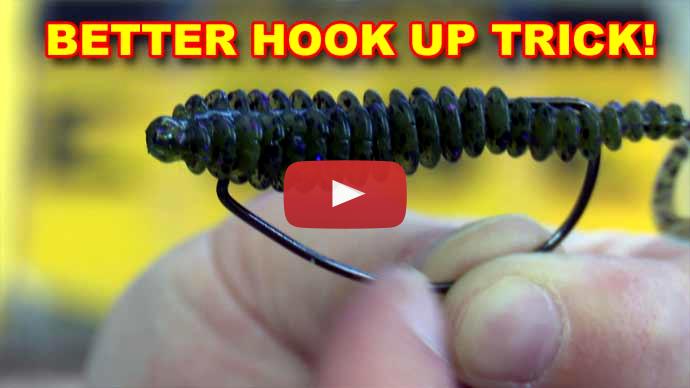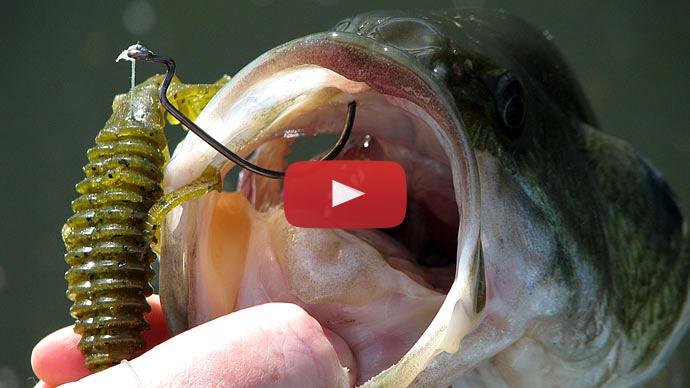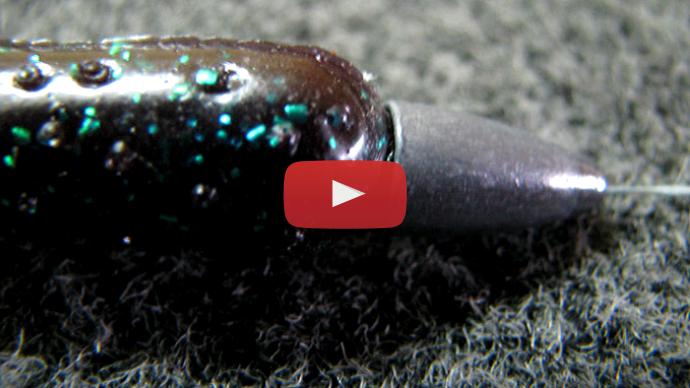Fishing Texas rig baits during the spring, that's what we're talking about today. There's a lot of questions. I see 'em all the time on our forums because there's so many different creature baits out there, right, that you can Texas rig, and there's a lot of different ways to fish 'em, seemingly, but I'm gonna make it simple for you. I'm gonna break it down to a couple of different ways you can fish 'em no matter what creature bait you're throwing, as long as it's Texas rig in the springtime from pre-spawn all the way to post-spawn.
So, let's start off with my rigging. First thing I wanna to tell you about what I do is I use a 7 foot 1, 7 foot 2 medium-heavy power fast action rod bait casting. That is your jack of all trades, your Swiss army knife of bass fishing. You can use that for a variety of different lures and techniques, but it works especially well for worm fishing. Matter of fact, I have several just dedicated for worm fishing. That's how good it is. So, get one of those rods, pair it up with a reel with a lower gear ratio, like a 6.3 to 1, 6.2 to 1 gear ratio. And then I use InvizX Fluorocarbon. That's Seaguar line, okay? The reason I do that, it's 15-pound. I don't use braid and I'm not using any liter or anything like that. The reason is that a fluorocarbon line is much more versatile. You can use that in just about...you can throw it pretty much in anywhere and not have any problem with it.
Braid is more specific, and braid has a few issues with it. If you're throwing in a lot of woody cover, flooded woody cover, like bushes, trees, some docks, you get heavy fish on there. Braids are known to kind of cut into that wood because it's soft and it gets stuck in there. Fluorocarbon won't do that as much. Same thing with, if you're fishing around a lot of rocks like riprap and such, braid tends to get frayed easier and nicked up easier than fluorocarbon. You know, you would think it'd be the other way around, but no, that's not the case.
So, I'd just like to use fluorocarbon for this stuff, this type of fishing. And what I'll do is I'll rig the Texas rig bait. I'll use a three-out hook, three-out extra wide gap hook, that's from...you know, Gamakatsu makes a great hook for that. Just a normal size, not a flipping hook or anything like that, just a regular hook. And the weight is, I'll use a three eighth ounce weight, tungsten weight. That's your standard size weight. Now, these baits are pretty bulky, they often have appendages on 'em, they slowly move through the water column, so a heavier weight like a three eighth ounce weight is what you'll need to give that nice, steady slow while still getting the appendages to move around as it's falling. So, that's, like, my standard setup, my standard go-to setup.
So, let's talk about during the spring, throughout the spring period, and how I fish it. Let's start off with the pre-spawn period. Pre-spawn, for me, is, like, when the temperatures are in the upper 40s, getting into the mid to upper 50s. That range is pre-spawn. And in the early pre-spawn, when the water's really cold, that's when I'll fish real slow. Oftentimes what I'll do, is I cast out, let the lure hit the bottom. And here what I'm doing is I'm fishing 10 to 15 feet deep. Sometimes, I'll fish deeper, depending if the fish haven't moved up yet. I may have to go 25 feet deep. Fishing points, main point structure, I think main lake structure, main lake points. Throw it out and watch the bait fall. Watch where the line enters the water. You wanna give it a lot of slack. Don't cock the reel after it hits the water. Instead, pull some line out of the reel so that it's slack line and watch that bait. Just fall through the water column. Watch that line. That line sometimes will make a little twitch or a bounce. Well, that's a fish grabbing it. That's how you detect a strike. Or sometimes, it'll start to suddenly accelerate as it's peeling, going into the water. Like, well, fish grabbing it, swimming away with it now, things like that. Watch for those little changes. And sometimes, they're subtle, and that often means a bite.
But once it hits the bottom, reel up on it, feel, and sometimes you're line's swimming off, that's a fish that's got it, so set the hook. But if there isn't a fish there, again, when the water's really cold, I like to drag it on the bottom. Just give it slow pulls. And I like to use it with the rod, not with the reel, because the rod, I can tell how far I've pulled that bait. So, just kinda pull it back couple of inches, 3, 5 inches at the most and pause it. Reel up that slack and just wait. And that pause can be anywhere from 5 to 30 seconds long, but what you're doing here is you're giving the fish time to examine it, come up to it. Sometimes, they're a little skittish early in the spring when they first come up, so they're not as willing to bite something that looks a little unusual to them, they might actually be spooked by it. So, a slow presentation. Also with the water being really cold, a lot of bait fish and such, they're not super active, so you're trying to match the activity level of the forage. So, just drag it, pause it, long pause, and then drag a little bit more again, long pause, drag a little bit more, long pause. And oftentimes, the fish will just pick it up. You'll just see the line just start to swim away, like fish. It's amazing how that works.
As the water warms up, then I like to, you know, throw it out there and let it drop. Again, you're just watching for that bite. And once it hits the bottom, let it pause again for another, you know, 5 to 30 seconds, but then lift the rod up, you know, about a foot or so. Lift it up about up to the 9:00, 10:00 position, let it drop again on slack line, watch for that bite, reel back up, give it a long pause, pick it back up again, let it drop. So you're just letting that bait slowly hop its way towards you, and a lot of times, that generates bites. And then the third way I like to fish that creature bait is I like to throw it out and swim it back, reel it real slow right along the bottom or right over the tops of weeds and just let those appendages just flap and flutter and make it look like something's swimming along. And just a straight steady retrieve is all you need, and oftentimes, you'll get a bite that way. It's great, especially if a crank bait's too aggressive or too fast or making too much noise and the fish aren't biting it, or if you're fishing crankbaits and you got fish following it, but they won't bite it. Pick up that Texas rig creature bait, throw it out there and fish it like you would a crankbait, just a little bit slower, and a lot of times you'll get a bite. There's a tip from your Uncle Glen.
You know, and one other way to do it when you're reeling it, you can also, yo-yo it, you know, bring the rod tip up and ring it down. You can pause it just like you would a crankbait. Try those type of different retrieves and you'll be surprised at how many times you get bit that way. A lot of guys don't fish Texas rig plastic baits that way, so it's something that the fish don't normally see, and you tend to get more bites that way.
Now as we move into the spawn, I change things up a bit. The spawn, the fish are on beds, they're locked down, they're a little spooky, you know, because they are shallow, so any quick movements or something around them might spook 'em off the bed. So, here, I'll go weightless or real lightweight, maybe an eight-down sinker, and I'll put it on spinning gear. Again, I'm using a 7 foot 1, 7 foot 2 medium power fast action spinning rod. I'll lighten up the line to maybe 10 pound fluorocarbon line. And here what I'm doing is you want to cast past the bed. And with that real lightweight, it's just gonna plop down lightly on the water. You don't make a big splash down. Sometimes, you can fish it completely weightless. But you're looking for this nice tantalizing fall. If it falls just like a stick and doesn't really move, the appendages don't do it then maybe you might wanna add a little bit of weight because you want those appendages make it look alive. Throw it out there past the bed, and then just kinda slowly reel it a little bit so it swims towards the bed and lands on the bed if you can do that.
A lot of times, the fish will turn on it and hit it before it even hits the bed. The key to that is staying far away from the bed. You wanna make long casts. The clearer the water it is, the further away you wanna be from the bed, especially if you're on the shore. Even the vibrations of you walking on the shoreline or walking through the bushes and stuff, that can tip the fish off that you're there, so making longer cast, staying away from the bed, making long cast past the bed, and working it over to it with a weightless or a very lightly weighted Texas rig bait is the best way to get those fish to bite.
Now, once you get past the spawn, I go back to that bait casting rig again with actually three eighth ounce tungsten weight, and I'll do the same retrieves I did in the pre-spawn, except I'll swap out that slow dragging retrieve, and I'll replace that with swimming on the surface. Here, you might use, oh, I'll say... I might lighten up a little on the weight, use a quarter ounce weight. But you wanna throw it back and just swim it across. Just reel it nice and easy and just swim it across the surface, and it just kinda gurgles and makes a little bit... It's more subtle than a buzz bait. And in the post-spawn part of the season, that is when the fish are really aggressive, they really do hit topwater a lot, and this could be a dynamite way to catch fish, especially if a lot of guys are out there throwing poppers and buzz baits. This is a presentation the fish don't see that often, and you can cash out on 'em, man. You can load the boat and catch a lot of fish that way. So, that's swimming it on the surface, swimming it subsurface, that's another way to do it, just like again, with the crankbait.
And then I go back to the hopping it as well, dropping it, vertically fall, hit the bottom, but here I'm not waiting that 5 to 30-second wait. I'll let it, you know, sit a second or two and then lift it back up and let it drop. And here I'll only do like two, three drops and then reel it back in and make another cast. I don't work at all the way back to the boat. Typically, if the fish are gonna bite it that time of year, they're gonna do it on the first drop or two, or the first hop or two, and then you just move on. So, you can save yourself a lot time not wasting your time working the bait in unproductive areas.
So, that's how I fish Texas rig baits. I hope that helps. For more tips and tricks like this... Wait, hold on, hold on. If you watched the video this long, then you for sure don't wanna miss these two videos. All right, now this one I handpicked for you because I think this is the one you're gonna wanna see next, but this is the one that YouTube thinks that you should watch. Either way, I'm in both of them, so I'll see you in a few seconds.



